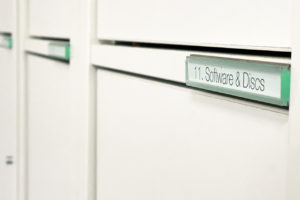Wayfinding Planners: Advocates for Healing-Focused Environments

When people think of hospital wayfinding, they focus on the tangible aspects of our business: digital signage, modular signage, kiosks, directories, panels, and even the humble face plates. What’s less obvious, though, is the critical role that wayfinding and the designers behind all the displays and signage play in the overall healthcare experience for medical staff, patients and visitors.
The primary goal of the wayfinding expert is to create a logical, intuitive navigational system – using signage, lighting, architectural design, and even natural elements such as foliage – so that when people enter a facility, they will be able to make their way from Point A to Point B with minimal fuss or trouble. Hospitals are inherently stressful environments, and the inability to find a patient room, a doctor’s office, an exam room, or the emergency room can not only be a source of frustration and pain for a visitor and/or patient, it can also mean the difference between health and illness. Wayfinders thus must balance aesthetics and function as they design navigation systems that will allow people to make the right choices with each “decision point” they encounter on their routes.
Another challenge that hospitals present to wayfinding designers is the fact that hospitals usually serve multiple audiences: doctors and nurses with different specialties (cardiology, radiology, urology, physical therapy, etc.); auxiliary medical personnel with different job functions (technicians, technologists, medical assistants, phlebotomists, etc.); volunteers; visitors with different needs (family members, friends, jobseekers, delivery staff, etc.); administrative/technical staff (housekeeping, gift shop attendants, cooks, orderlies, chaplains); “other,” often temporary visitors and staff such as emergency response teams, researchers, and law enforcement officers; and of course, the patients themselves.
Each of these groups will have different needs. Even patients within a single department might have entirely different wayfinding needs from each other. A patient in the Gastroenterology (GI) department might simply be there for a regular checkup, but another might be there for an outpatient procedure such as a colonoscopy and will therefore need guidance on locating the right room. Yet another might need bloodwork in addition to a regular visit and will want to know how to get from the GI offices to the lab, which may be in a different building altogether. An especially large hospital campus will need a more sophisticated yet very simple wayfinding system that will accommodate all of these different needs.
The hospital exterior shouldn’t be neglected when designing an effective, efficient wayfinding system as well. Large metropolitan hospitals such as Cedars-Sinai in Los Angeles, or research hospitals such as St. Jude’s Hospital in Memphis, TN, or the University of Texas Southwestern right here in Dallas, all receive hundreds, if not thousands of out-of-town visitors and patients each year. The Mayo Clinic in Scottsdale alone serves 90,000 patients from all 50 states and a number of foreign countries. Each of these institutions must create wayfinding systems that will resonate with visitors and guests whose places of origin, cultural reference points, and even language skills may vary tremendously from one person to the next. In addition, even local audiences such as emergency response teams must be able to quickly find their destination – for them, good wayfinding can literally mean the difference between life and death.
Most experts in hospital design, including architects, designers, and wayfinding experts, thus now recognize that a facility’s layout and navigation system can be just as important – if not more so – as the color of patient rooms and the texture of lobby carpeting in creating a patient-focused, health-affirming environment. The tension between form and function continues to plague many involved in hospital design – who hasn’t heard of a designer and wayfinding consultant disagreeing over signage? – but as more evidence mounts regarding the impact of design on patient care, the future will likely see more collaboration between them in their joint efforts towards improved health outcomes.

